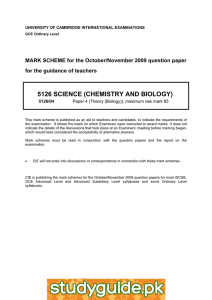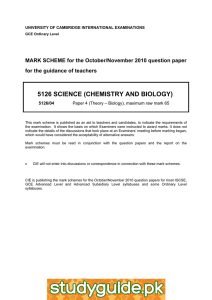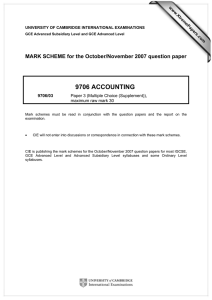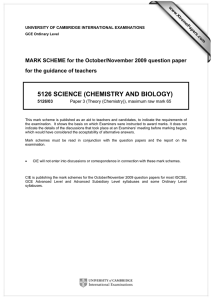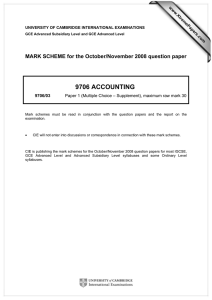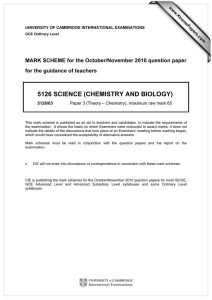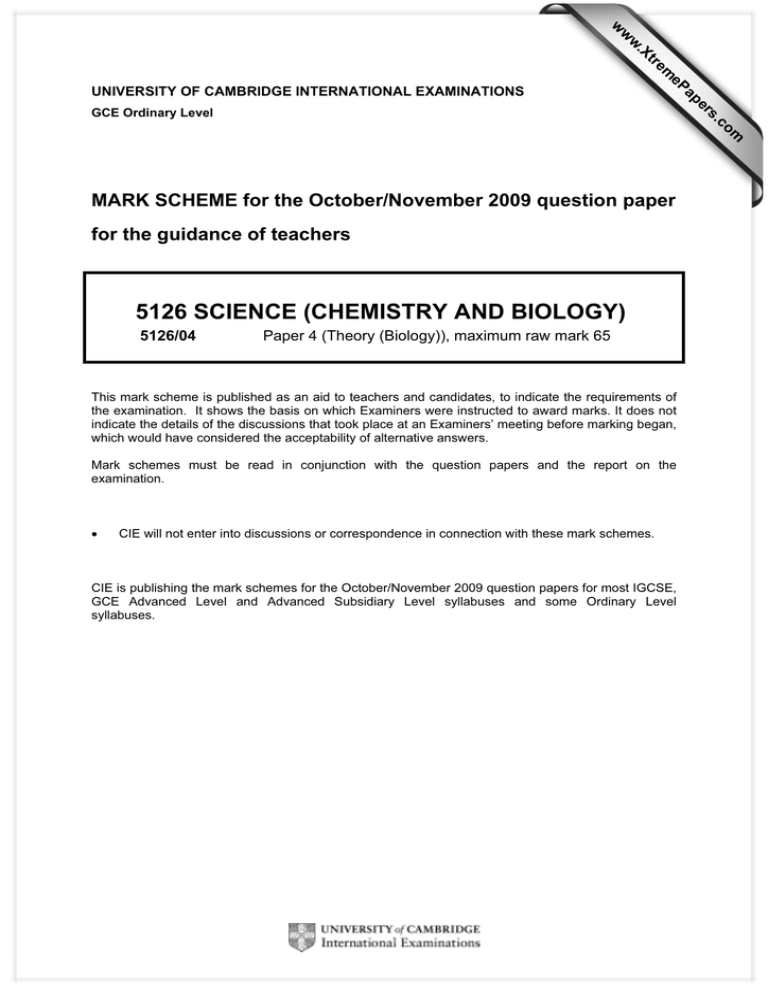
w
w
ap
eP
m
e
tr
.X
w
UNIVERSITY OF CAMBRIDGE INTERNATIONAL EXAMINATIONS
s
er
om
.c
GCE Ordinary Level
MARK SCHEME for the October/November 2009 question paper
for the guidance of teachers
5126 SCIENCE (CHEMISTRY AND BIOLOGY)
5126/04
Paper 4 (Theory (Biology)), maximum raw mark 65
This mark scheme is published as an aid to teachers and candidates, to indicate the requirements of
the examination. It shows the basis on which Examiners were instructed to award marks. It does not
indicate the details of the discussions that took place at an Examiners’ meeting before marking began,
which would have considered the acceptability of alternative answers.
Mark schemes must be read in conjunction with the question papers and the report on the
examination.
•
CIE will not enter into discussions or correspondence in connection with these mark schemes.
CIE is publishing the mark schemes for the October/November 2009 question papers for most IGCSE,
GCE Advanced Level and Advanced Subsidiary Level syllabuses and some Ordinary Level
syllabuses.
Page 2
Mark Scheme: Teachers’ version
GCE O LEVEL – October/November 2009
Syllabus
5126
Paper
04
Section A
1
(a) (i) Any two from:
no chloroplasts;
no cell wall;
no large / central vacuole;
cilia present;
[max. 2]
(ii) control passage of substances into;
and out of cell;
(b) (i) root hair cell
[2]
[1]
(ii) elongated part / hair;
gives large surface area;
for rapid absorption of water;
[3]
[Total: 8]
2
(a) (i) passage of water;
from region of high water concentration to region of low water concentration /
down a water concentration gradient;
through a partially permeable membrane;
(ii) when water concentration of cell sap lower than epidermal cells;
water passes by osmosis into guard cells making them swell and open stoma;
(b) (i) carbon dioxide + water glucose + oxygen;
(accept correct symbol equation 6CO2 + 6H2O C6H12O6 + 6O2)
[3]
[2]
[1]
(ii) carbon dioxide enters through stomata;
by diffusion (from air);
[2]
(iii) water is lost through stomata;
oxygen is lost through stomata;
[2]
[Total: 10]
3
(a) (i) points correctly plotted +/− one small square (one mark lost for each error);;
(ii) straight line drawn within +/− one small square of each point;
[2]
[1]
(b) read +/− one small square from graph (expect 174);
[1]
(c) (i) by haemoglobin;
in red blood cells;
[2]
(ii) glucose + oxygen carbon dioxide + water;
© UCLES 2009
[1]
Page 3
Mark Scheme: Teachers’ version
GCE O LEVEL – October/November 2009
Syllabus
5126
Paper
04
(iii) at higher speed muscles are used more / more active / contract more frequently;
respiration rate increases so more oxygen / oxygenated blood needed;
heart rate increases to supply more oxygen / oxygenated blood
[3]
[Total: 10]
4
(a) removal of toxic materials;
and waste products of metabolism (from an organism);
[2]
(b) (i) water;
and urea;
because concentration higher in urine than plasma;
[3]
(ii) amino acids broken down to urea;
in the liver;
(c) (i) carbon dioxide;
[2]
[1]
(ii) high surface area;
one cell thick;
moist surface;
[3]
[Total: 11]
5
(a) (i) low at night / minimum at about 05.00;
high in day / maximum at about 14.00;
[2]
(ii) photosynthesis requires energy from sunlight;
only occurs in daylight / maximum when light brightest;
[2]
(b) (i) sugar concentration in stem increases after that in leaves;
[1]
(ii) in phloem;
[1]
[Total: 6]
© UCLES 2009
Page 4
Mark Scheme: Teachers’ version
GCE O LEVEL – October/November 2009
Syllabus
5126
Paper
04
Section B
6
(a) differences: sexual requires two parents, asexual only one;
sexual involves male and female gametes, asexual does not;
sexual produces genetically different offspring, asexual identical;
[max 2]
advantages: sexual allows variation;
asexual allows more rapid growth of population / asexual can occur easily in a
widely dispersed population;
[2]
(b)
R
r
r
Rr
red
rr
blue
r
Rr
red
rr
blue
any appropriate style of diagram showing alleles in gametes of parents;
two Rr offspring;
two rr offspring;
Rr identified as red;
rr identified as blue;
50 red and 50 blue;
(allow ecf at all stages)
[6]
[Total: 10]
7
(a) Any six from:
set up container with starch solution;
one container for each pH value;
add amylase and start timer;
remove samples at time intervals and test with iodine;
note time when no longer blue;
keep concentration and volumes of starch and amylase the same;
carry out at same temperature each time;
(allow valid alternative methods)
[6]
(b) soluble products of digestion;
pass through wall of small intestine/capillary wall;
into the blood (capillaries);
undigested food molecules too large to pass through / only digested food molecules
small enough to pass through;
[4]
[Total: 10]
© UCLES 2009
Page 5
8
Mark Scheme: Teachers’ version
GCE O LEVEL – October/November 2009
Syllabus
5126
Paper
04
(a) Any seven from:
bacterial feed on sewage in river / sewage causes bacteria to increase in number;
oxygen is used up;
fish / aerobic aquatic organisms die;
sulfur dioxide dissolves to form acid rain;
which kills trees / kills fish in lakes / erodes statues / damages buildings;
insecticide washed into rivers / blown over land;
insecticide accumulates up food chain / trophic levels;
poisons fish / toxic to humans / kills useful insects;
[7]
(b) paper is made from trees;
the more paper recycled the fewer trees need to be cut down;
more trees means more carbon dioxide removed from the air /
less greenhouse effect / less global warming;
[3]
[Total: 10]
© UCLES 2009

